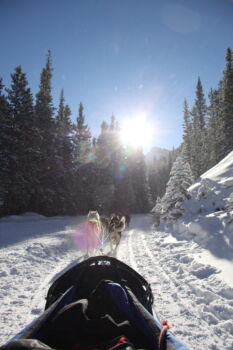Sled Dog Ethics & Best Practices DISPELLING THE MYTHS OF THE DOGSLED INDUSTRY
In an effort to be transparent to our customers and the general public, we are providing the following detailed information on our kennel and tour practices with the hopes of dispelling the myths of the dogsled industry.
In the past, Howling Dog Tours has been targeted with a campaign by animal activists making false accusations. Our dogs are the most important part of Howling Dog Tours. We hope the following information will give you the facts to make an educated opinion on how we love and care for our dogs.
Our Dogs
The dogs in our kennel are Alaskan and Siberian Huskies, a working dog that that is bred exclusively to run and pull, while living outdoors. They are not bred for colour, or looks, and are constantly evolving over the years, which has made them exceptionally suited for their job!
Over the last 50 years, the husky was crossed with breeds such as greyhound, and more recently German short haired pointer, to enhance the athletic qualities and make them very suited to running in team and pulling sleds, while loving the attention the staff and guests give them.
There is husky in every dog, so they keep the genetics of the double coat, which helps with both warmth as well as cooling.
Because of the climate in our area, which includes warm Chinooks and an average winter daytime temperature of -4 Celsius, we are not running the 70 lb large, hairy dogs, as it is too hot for them. We can put a jacket on the dogs when it is cold, but you can’t take anything off in the warm weather! The mixed breed also means less foot problems, significantly less hip problems, and generally less health problems overall than the purebred breeds.
One of the first things people notice is the varied size, shapes and looks of our dogs. We choose the dogs for their desire to run, while being friendly and having the genetic characteristics that allow them to live outside year-round.
Over the last 20 years, we have made it our philosophy to adopt dogs into the kennel rather than have litters of puppies. There are a variety of situations by which we obtain new dogs – kennel owners want to retire or downsize, they may experience financial restraint, or the dogs do not fit into race programs (too small, too large, too slow, etc).
We do not discriminate based on appearance (looks or size) or past life situation or ability. The dogs we adopt may need work with behaviours – they become well socialized with our staff numbers, as well as the number of guests on our tours that interact with them. Many have thrived better in our kennel because they get more attention and socialization than where they came from.
The staff to dog ratio at Howling Dog Tours is higher than any other kennel in the area because we have a guide on every team/sled that runs, which means every musher is part of the dog care program. This also includes owners, family and volunteers, all who have vested interest in high standards of dog care.

Housing
Both owners, Rich and Dana, lived in the arctic for a number of years with sled dogs. We had some shorter haired dogs in Yellowknife and developed strategies so they remained healthy and happy in that environment. A lot of what we learned in the Arctic, we use today.
The style of house used which has been developed over time, includes a larger straw lip in the door to hold the straw inside; feet under the house so it is raised slightly off the ground; attached bowls so that water and food is not spilled or contaminated.
Being that the average winter daytime temperature in this area is -4 degrees Celsius, the climate does not dictate the use of insulation in the frame of the houses. We use plenty of straw, which is the number one way to insulate inside the houses. We customize the houses for the dog’s needs, physical size and preference. The houses can be positioned differently in the summer to provide more shade, or turned to avoid the windier winters, so they are not stationary. We have an extra supply of houses available on hand, in case of damage.
The kennel is configured to give each dog private space, while being able to play with their neighbors, go nose to nose, and stay in a team they know and are comfortable with. The majority of the kennel area has been cleared of trees for more air flow and sunlight, while eliminating the risk of falling trees. The gravel base in each dog’s space allows for absorption of rain so they are not in mud or water. The grass surrounding each dog is trimmed and left naturally for absorption and drainage, and keeps the outdoor, backyard look.
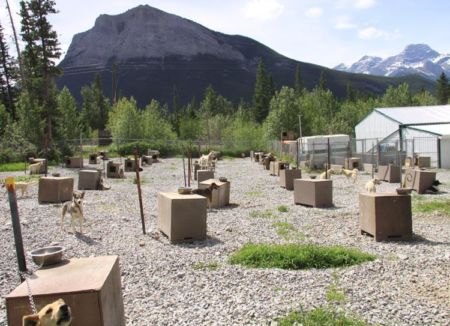
Tethering
There are many studies on the nature of tethering sled dogs; we would like to note the following: Dr. Houpt, the James Law Professor of Animal Behaviour in the Department of Clinical Sciences, College of Veterinary Medicine at Cornell University, published (with fellow researchers) the study “A comparison of Tethering and Pen Confinement of Dogs” in the Journal of Applied Animal Welfare Science. The study concluded that the tethering of dogs is a safe and humane means of confinement. Veterinarians recognize this, and experienced mushers use the tethering as a preferred method of confinement.
At our kennel, the sled dogs are tethered individually. We are legislated to use the tethering system, however we have special permission for our dogs to run free in an enclosed free-run area, as long as we have staff with them at all times. We also have permission to use a treadmill for training in our kennel.

Exercise
Winter sledding time and training gives these dogs considerably more exercise than the average pet. Our run to rest ratio is kept at 2 days on, 1 day off during the winter months. Exceptions do apply – no dog is forced to run if they do not want to; we can rest them. Each dog has their own capabilities, so we tailor the amount of running to each dog. If they are semi-retired, they do not run the full schedule. If they are retired, they may run once a week in our teams, but get more free-run time. We do not run in temperatures colder than -25 Celsius.

Free Run
Howling Dog Tours is the only kennel in the area with 2 large free run areas (1 acre), separate from the dogs on tethers. During the off-season, we can take the dogs to this area for running and playing. We have a volunteer program, open to the public, to free-run the dogs, weather permitting. We are also developing a program called the “Brush and Cuddle Club”, designed for people who are not physically able to help with the free-run program, as it is less physical. This provides stimulation and socialization for the dogs when they are not running tours.
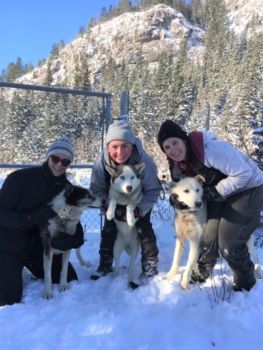
Treadmill
Our treadmill is the first one developed in Canada, for large scale training, conditioning and pre-season exercise. In the past, we used a quad to train the dogs on trails outside the kennel; however the trails became restricted due to park land, thus the treadmill was put in. It is one of 3 treadmills for sled dogs, the other 2 being professional mushers in Alaska. We are the only company in the area that does this type of fall training. This type of training gives us the capability to control the pace and is used for conditioning, which is essential for physical fitness when running tours in the winter. Any dog that does not want to run on the treadmill is given alternate training in the free run area instead. Although our treadmill includes an air conditioning system and misting system for use in warmer fall weather, we do not use it in hot summer months.
With the treadmill, free-run and volunteer programs, there is plenty of off-tether time and socialization for each dog in the non-tour season.

Food and Water
At our kennel, we feed a premium diet of raw chicken which is custom blended for our dogs. While some kennels do not feed raw, or chose to only feed it during the winter months, we feed it 12 months of the year. Our walk-in commercial freezer, on site, holds 60,000 lbs of chicken at one time, so there is never a problem with supply! We also feed a custom dry kibble, made in the Horizon factory in Saskatchewan, and it far exceeds the protein/fat content that most store bought foods provide. We prepare 200-300 lbs of chicken, plus 100 lbs of kibble daily. The dogs also get 60-100 lbs of premium dog treats per month, as well as supplements, as required, such as beef or pork fat, zinc, omega oils, and kelp.
Howling Dog Tours is the only kennel in the area with an on-site water well. To ensure our dogs get the water they need, it is mixed in with the chicken for the main meal, and is baited with chicken when watering pre – or – post run (plain water is not always taken). In summer months, their bowls are filled with water in the morning and evening. They receive about 7 cups with their main meal as well. In the winter, as it is added to their meal, they drink it before it freezes. In general, they are offered 8-12 cups per day, plus 6-8 cups with the meal – this is 18 cups of water per day, if they want it, which is exceeds the basic requirements for food and water.

Cleaning
We are very strict about keeping a clean environment for the dogs, both at the kennel and the dogsled site. Dog feces is picked up and bagged on a daily basis, throughout the day at both sites, so it is not around the dogs. The bags are then removed from both sites and is trucked by a contractor to an appropriate land fill site, as per the municipal district regulations.
There is access to hot water on site at all times, for washing the food buckets, ladles and bowls.
All straw and box bedding is stored in a large covered shed, with at least 2-3 months of supplies on hand. The used straw or bedding is removed from the kennel by the same contractors as mentioned above.
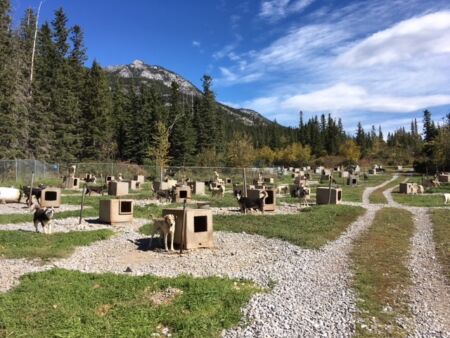
Vet Care
Howling Dog Tours is proud to have used the same veterinary clinic for 25 years! The team at the vet clinic has been helping us provide excellent care for our canine companions through dog visits to the clinic and veterinary visits to our kennel. This relationship allows for us to receive immediate care when required; the vets know our dogs and keep professional and extensive kennel records.
The veterinary involvement includes emergency or medical problem care, an annual kennel visit where they inspect every dog, yearly vaccinations, consultation on deworming programs, dental checks and procedures, as well as humane euthanization. On site, we have first aid supplies and bulk medications for veterinary guided use. The vet team is available to be contacted 24/7, to discuss any matter relating to the dog’s health. Medication and veterinary care is provided whenever deemed necessary by the vet team.
All our dogs are under veterinary care from the start of life to the end. Consultation on quality of life and end of life decisions are done as situations arise. It may be determined to retire the dog, adopt the dogs out, or provide medical care for terminal illness as long as quality of life is good. When it is determined that a euthanization is to be performed, this is always done by the veterinary team, who has the final say in end of life decisions for our sled dogs. Howling Dog Tours does not perform any type of euthanization; it is always done at a qualified vet clinic.

What happens to senior dogs?
As the dogs age, we look at several options and make decisions that are best for each dog. 1) semi-retirement, which means limited running schedule, suited to each dog. 2) possible re-homing the dog. 3) separate exercise program for enrichment in retirement. If they are retired and not suitable for adopting out, the dogs will always have a home with us, to enjoy their retirement with the rest of their pack. Quality of life is monitored continuously. We do not have an arbitrary age for retirement or euthanization; each dog is treated individually.
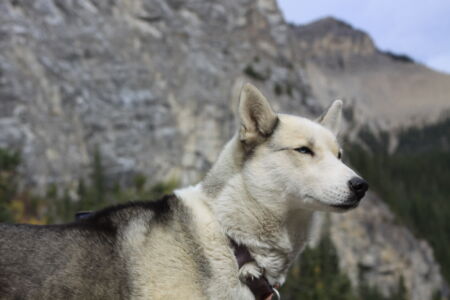
Government Regulations
Howling Dog Tours is a professional kennel and tour company, therefore we have to follow all regulations set forth by the Municipal District, the Province of Alberta, the SPCA, and Mush With Pride (an organization of mushers who set standards in sled dog care and support humane treatment of all dogs, and is dedicated to enhancing the care and wellbeing of sled dogs in their own traditional and modern uses). There are some requirements that animal rights/eco-terrorist groups are unhappy with, such as tethering laws. Our permits require that all dogs are to be tethered at all times. This includes the kennel and the trail area where the dogs run in the Provincial park. We have asked for an exemption and been granted permission to use the treadmill and free run areas with increased staffing.
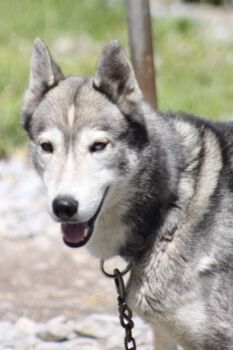
Touring Etiquette
Our company is limited as to how many dogs we can use each day when running tours, and we choose not to run at our maximum sled allotment, because to do so requires the dog teams to run 4 times per day, back to back. This is our choice for the well being of our dogs. We choose our dogs over profit! Our staff ratio is higher than any other kennel in the area because we run a guide on every sled/team, and every musher is part of the dog care program. Our kennel of 200 dogs allows for a proper run/rest rotation, which is scheduled to allow for happy, healthy dogs at all times.
At Howling Dog Tours, we have always run only guided sleds for the following reasons. The safety of the dogs comes first! Without extensive training, it is not fair to put someone on the trail and expect them to navigate or control correctly, to avoid incidents that could cause injury to themselves or the dogs. Our guides, with extensive training, are able to provide a safer experience to our guests without losing the thrill of mushing. Guided sleds ensure the practice of safely running a team of dogs at all times. We don’t believe training a guest for a short period of time provides an appropriate or safe command of running a dogsled team. A guided sleds also means every dog is observed consistently while running, and behaviors are controlled, minimizing risks of dog injury.
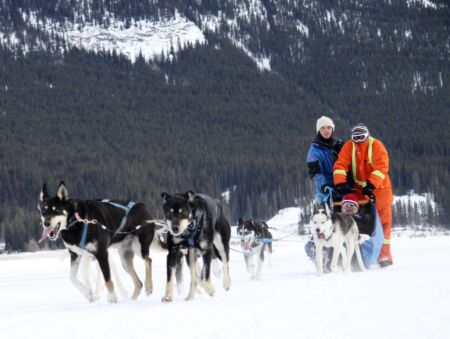
Conclusion
We wish to thank you for taking the time to read this. It was not put together as a sales platform – it was done to give correct information as to how we run Howling Dog Tours. Please continue to do your research and form an educated opinion. This effort is to increase our already transparent dog practices with the hopes of dispelling the myths of the dogsled industry, while condensing the information we have provided to our guests, the public, and our staff for over 25 years.
